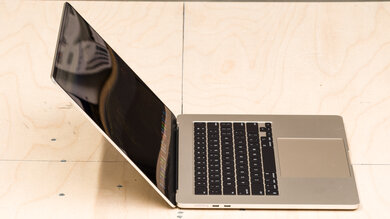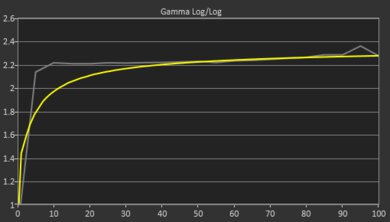The Apple MacBook Air 15 (2024) is a premium ultraportable laptop. It replaces the M2 Apple MacBook Air 15 (2023). This new model sports an M3 SoC with eight CPU cores and ten GPU cores, which brings a few new features, like hardware-accelerated ray tracing, Dynamic Caching, and an AV1 decoder engine. RAM and storage max out at 24GB and 2TB, respectively. Other changes include support for two external displays (with laptop closed), Wi-Fi 6E, and a more smudge-resistant coating on the Midnight model. It has a 60Hz 2880 x 1864 Retina display, a 1080p webcam, and a 67Wh battery. Its port selection comprises two USB-C/Thunderbolt 3s, a MagSafe charging port, and a 3.5mm headphone jack. It's available in four colors: Space Gray, Silver, Starlight, and Midnight.
See our unit's specifications and the available configuration options in the Differences Between Variants section.
Our Verdict
The Apple MacBook Air M3 is excellent for school use. It feels incredibly well-built, and thanks to its compact design, it's easy to carry around. Overall, it provides a great user experience with a sharp, bright display, a spacious keyboard, and a large, haptic touchpad. Its M3 SoC can handle general productivity tasks like text processing, web browsing, and video playback. You can perform more demanding tasks like video editing, programming, and 3D graphics, but you might not get the smoothest experience if the material is highly complex. Battery life is amazing at around 12 to 13 hours of light use. Unfortunately, it only has two USB-C ports, and while it can output to two external displays—an upgrade over its M2 predecessor—it can only do so with the laptop closed.
- Well built and easy to carry around.
- Sharp, bright display.
- Comfortable keyboard, gigantic touchpad.
- All-day battery life.
- M3 SoC can handle some demanding tasks.
- Limited port selection.
- Some thermal throttling under load.
The Apple MacBook Air M3 is sub-par for gaming. Although its M3 SoC can handle some older and highly optimized titles, it'll struggle to maintain playable frame rates in graphically demanding games. Also, most games must run through Rosetta 2 since they lack optimization for Apple silicon, so the performance can vary greatly depending on the game. It has a 60Hz display with a slow response time, resulting in a blurry image with visible ghosting in fast-moving scenes, and it doesn't support variable refresh rate to reduce screen tearing. On the upside, it doesn't get hot under load, and there's no fan noise since it's a fanless device.
- Comfortable keyboard, gigantic touchpad.
- M3 SoC can handle some demanding tasks.
- Fast SSD.
- Few games optimized for Apple silicon.
- 60Hz display with slow response time and no VRR.
- Limited port selection.
- Soldered RAM and storage drive.
- Some thermal throttling under load.
The Apple MacBook Air M3 is great for media consumption. It's easy to carry around, and its battery lasts around 12 hours of video playback, giving you plenty of time to get through multiple full-length movies and TV show episodes. The display looks sharp, bright, and color-accurate; however, it isn't the best for dark room viewing, as its low contrast makes blacks look gray. The speakers are among the best you can get on the market; they get very loud, producing a full and well-balanced sound with a good amount of bass.
- Well built and easy to carry around.
- Sharp, bright display.
- Loud speakers with a full, well-balanced sound.
- All-day battery life.
- Superb factory calibration.
- Blacks look gray in dim settings.
- No touch input.
The Apple MacBook Air M3 is very good for use as a workstation. Its M3 SoC can handle some demanding workloads, like video editing and programming; however, you might experience some slowdowns and stutters if the material is highly complex (particularly GPU-intensive workloads), and completion times will be slower than most workstations with an active cooling system. Also, you can only get up to 24GB of soldered RAM, which might not be enough for some people. Color correction work is possible, as the display has full DCI P3 coverage and exceptional factory calibration. The keyboard gets quite toasty under load and can cause some discomfort, but thankfully, there's no fan noise since it's a fanless device. Unfortunately, it only has two USB-C ports and can only support two external displays (with the lid closed).
- Comfortable keyboard, gigantic touchpad.
- M3 SoC can handle some demanding tasks.
- Fast SSD.
- Display has full DCI P3 coverage.
- Superb factory calibration.
- Limited port selection.
- Soldered RAM and storage drive.
- Some thermal throttling under load.
The Apple MacBook Air M3 is great for business use. It's very portable for a 15-inch model, and its battery lasts comfortably through a full workday of light use. Its M3 SoC can handle most productivity tasks, like text formatting, spreadsheets, and presentations, and you can even do some light photo and video editing. The display looks sharp and bright, the keyboard is comfortable to type on, and the touchpad is large and responsive. Its 1080p webcam is excellent, so your colleagues and clients can see and hear you clearly on video calls. The main downside is that it only has two USB-C ports. It can output to two external displays, which is an improvement over its M2 predecessor, but it can only do so with the laptop closed.
- Well built and easy to carry around.
- Sharp, bright display.
- Comfortable keyboard, gigantic touchpad.
- All-day battery life.
- M3 SoC can handle some demanding tasks.
- Limited port selection.
- Soldered RAM and storage drive.
Changelog
- Updated May 07, 2025: We've updated this review to Test Bench 0.8.3, which removes the viewing angle tests and adds a GPU Total Graphics Power comparison in the GPU section. The Pen Input test in the Extra Features section has also changed, as it now shows whether the laptop supports pen input rather than the inclusion of a stylus in the box. See the changelog for more details.
-
Updated Apr 04, 2025:
We've added the Apple MacBook Air 15 (M4, 2025) as an alternative with better external display support in the Ports section.
-
Updated Mar 28, 2025:
We had incorrectly listed the charger size in our Portability section as larger than it is. We've updated our review with the correct volume.
-
Updated Mar 24, 2025:
Added mention of the Lenovo ThinkPad X9 15 Aura Edition (2025) in the Contrast section as an alternative with an OLED display.
Differences Between Sizes And Variants
We tested the Apple MacBook Air 15 with an M3 SoC (10 GPU cores), 8GB of RAM, and 256GB of storage. The RAM, storage, and color are configurable; see the available options in the table below.
| Screen |
|
|---|---|
| SoC |
|
| Memory |
|
| Storage |
|
| Color |
|
See our unit's label here.
Popular Laptop Comparisons
The M3 Apple MacBook Air 15 is one of the best ultraportable laptops on the market. Its build quality, as well as the quality of its speakers, touchpad, and webcam, are industry-leading. Its battery life is also among the best in its class. However, its port selection is very limited. Additionally, while its Retina display is among the brightest, it's starting to fall behind the competitors, as many Windows laptop manufacturers are offering displays with a higher refresh rate and a wider color gamut.
See our recommendations for the best lightweight laptops, the best travel laptops, and the best laptops for college.
The Apple MacBook Pro 16 (M4, 2024) is much better for most uses than the Apple MacBook Air 15 (M3, 2024). The MacBook Pro is a much more powerful device designed for the most demanding workloads, while the Air is an ultraportable designed for general productivity tasks. The Pro has a superior display that gets brighter and has a higher refresh rate, a wider port selection with Thunderbolt 5 ports, and fuller sound speakers. Also, since the Air relies on passive cooling, it doesn't perform as well during sustained workloads.
The Apple MacBook Air 15 (M4, 2025) is the next generation of the Apple MacBook Air 15 (M3, 2024) and presents minor upgrades. The biggest changes are in the SoC and port selection. The M4 SoC provides a decent performance uplift, and the Thunderbolt 4 ports allow you to run two external displays simultaneously with the built-in display. Besides the new 12MP webcam with Center Stage support, the user experience is essentially identical between these models; the display, touchpad, and speakers are the same and generally fantastic. The typing experience is the same as well and leans slightly harsh, owing to the short key travel and rigid keyboard deck, though.
The Microsoft Surface Laptop 7th Edition 15 (2024) and the Apple MacBook Air 15 (M3, 2024) are both 15-inch ultraportables and direct competitors. Both laptops provide an amazing user experience, though the Surface Laptop beats the MacBook Air in a few areas, as it has a brighter 120Hz display, a wider port selection, Wi-Fi 7 wireless connectivity, and a much longer battery life. On the other hand, the MacBook Air has a larger touchpad, and unlike the Surface, it's a fanless device. Performance-wise, the Surface Laptop's Snapdragon SoC is faster than Apple's base M3 chip in heavy, multi-threaded workloads. However, the MacBook Air comes out ahead when considering app compatibility, as there are more apps that run natively on MacBooks with Apple silicon than Windows on ARM, and at the time of writing, Apple's Rosetta 2 emulation is more mature than Microsoft's Prism.
The Apple MacBook Air 15 (M3, 2024) is a larger version of the Apple MacBook Air 13 (M3, 2024). These two laptops are very similar overall, so the buying decision largely comes down to size preference. The 15-inch gives you more screen space for multitasking, and you also get more space on the keyboard deck to rest your palms when typing. It also has better speakers than its smaller sibling; they sound fuller and richer, with more bass. Configuration-wise, although both are available with an M3 SoC, know that the base 13-inch model has an 8-core GPU (upgradeable to 10 cores), while the base 15-inch model only has a 10-core GPU option. The performance difference between the 8- and 10-core GPU is noticeable in some workloads but not significant. If your workload requires good sustained performance, it's best to go with the 15-inch, as it doesn't throttle as much.
Test Results

The Apple MacBook Air M3 is available in four colors: Space Gray, Silver, Midnight, and Starlight. See the bottom of the laptop here.
The Apple MacBook Air M3's build quality is outstanding. It has a full-aluminum chassis that feels solid and hefty. The display doesn't twist when manipulating it, and the lid and keyboard deck have little to no flex. The finish is fairly scratch-and-smudge-resistant; you'll get more fingerprints on the Midnight model, though not as much as the M2 MacBook Air, thanks to a new coating. The feet feel solid and stick firmly to the bottom of the laptop.
It's worth noting that many MacBook users have commented on how quickly the keycaps pick up smudges and develop a permanent 'shine' (often seen on keyboards with cheap ABS keycaps), which is disappointing for such a premium laptop, as it makes it look dirty and used. This isn't a grease build-up, and regular cleaning doesn't help much in preventing it. There are third-party solutions to protect the keycaps, like keyboard covers and stickers, but they may alter the typing experience.
The hinge is outstanding. It feels smooth when opening and closing the laptop, and it has just enough resistance to keep the screen in place without feeling overly stiff, so it's easy to open with one hand and adjust to your preferred position. The screen only wobbles a little bit when typing heavily.
The Apple MacBook Air M3's serviceability is bad. To access the internals, you need to remove four P5 screws and unclip the bottom panel. Some of the clips are hard to undo and require care, as the bottom panel can bend. Unfortunately, the only replaceable part is the battery since everything else is soldered onto the motherboard.
The 15-inch Apple MacBook Air M3's display looks exactly like the 13-inch in terms of sharpness, as they have the same pixel density. The increase from 13.6-inch to 15.3-inch isn't huge; it makes split-screen multitasking a little more comfortable, as side-by-side windows can feel cramped on the 13.6-inch display. See the comparison (in the 'more space' scaling) here. You can hide the notch if it bothers you, but you'll lose some screen space and have a thicker bezel at the top.
The display's contrast ratio is good and within the typical range of most IPS panels. However, it's relatively low compared to other display technologies like VA and OLED. This contrast level makes blacks look gray in dim settings. Check out the Lenovo ThinkPad X9 15 Aura Edition (2025) if you want a similar laptop with an OLED display.
The display is bright enough for use in most settings, even outdoors in broad daylight. However, you may have trouble seeing some content in direct sunlight, especially with dark-colored content. It gets very dim at the lowest brightness setting, which is great for dark room viewing as it causes less eye strain.
The display's reflection handling is outstanding. Its glossy finish does a good job of reducing the intensity of direct, mirror-like reflections and indirect reflections from bright ambient lighting. You can still see some reflections when viewing bright-color content with the screen at max brightness, but they aren't overly distracting.
The Apple MacBook Air M3's out-of-the-box display accuracy is superb. Most color and white balance inaccuracies are extremely minor and hard to spot. The color temperature is slightly cooler than the standard 6500K target, giving the image a slight, near-imperceptible blueish tint. The gamma follows the sRGB curve almost perfectly except in very dark and bright scenes, which are a little too dark.
The display's color gamut is outstanding. It has full sRGB and near-full DCI P3 coverage, the color spaces used in most SDR and HDR content, respectively. Its Adobe RGB coverage is excellent but not enough for professional print photography as it's missing the saturated greens that define Adobe RGB.
The Apple MacBook Air M3 has a great keyboard. It's the same keyboard as its predecessor, the Apple MacBook Air 15 (2023). Its layout feels spacious and is easy to get used to. The keycaps feel smooth and high-quality, but as mentioned in the Build Quality section, they pick up oil and quickly develop a permanent shine with regular use. The keys are stable and tactile; however, they have a very short travel, and combined with the keyboard deck's stiffness, it can feel like typing on a hard surface, resulting in fatigue. Typing noise is relatively low and isn't bothersome in quiet environments. As for the backlighting, you can adjust the brightness manually through the settings or let the system adjust it automatically based on the amount of ambient lighting.
The Apple MacBook Air M3's touchpad is outstanding. It's large (roughly 33% bigger than the Apple MacBook Air 13 (2024)'s touchpad), smooth, and responsive to all movements and gestures. Like most recent MacBooks, it uses haptic feedback to simulate the clicks instead of physical buttons, allowing you to click anywhere. The haptic engine provides great tactile feedback and is relatively quiet.
The speakers get very loud with minimal compression artifacts at higher volume levels. They sound clear, full, and natural, with a good amount of bass. Although the frequency response chart looks quite different from the M2 Apple MacBook Air 15 (2023), both laptops sound nearly identical in person. The only perceivable difference is that this newer model sounds more spacious, and vocals aren't as forward as on the M2.
The Apple MacBook Air M3 has an excellent webcam. The image looks detailed, with true-to-life colors and proper exposure. Voices sound loud and clear over the microphone with little to no background noise.
The Apple MacBook Air M3 has the same port selection as its predecessor, the Apple MacBook Air 15 (2023). Both USB-Cs support USB 4/Thunderbolt 3 data transfer speed (up to 40Gbps), USB 3.2 Gen 2 (up to 10Gbps), DisplayPort, and charging. The only change in the new M3 model is its support for an additional external display (2 total); however, this only works with the laptop closed. This means you can use the built-in display alongside an external monitor with a max resolution of 6k @ 60Hz or two external displays, one with a max resolution of 6k @ 60Hz and the second with a max resolution of 5k @ 60Hz. Check out the Apple MacBook Air 15 (M4, 2025) as an alternative if you want to use two external displays simultaneously with the built-in display.
We can't confirm which wireless adapter the Apple MacBook Air M3 uses. Wi-Fi 6E gives access to the 6GHz band, providing faster speeds, lower latency, and less signal interference than previous Wi-Fi standards. However, you need a router that supports Wi-Fi 6E to benefit from these features.
The Apple MacBook Air 15 2024 is only available with an M3 SoC. This chip is identical to its M2 predecessor in core composition, meaning it has four performance and four efficiency cores. The M3 chip brings slightly better performance, as well as new features like an AV1 decoding engine (which makes playback of AV1-encoded video more efficient, resulting in longer battery life) and hardware-accelerated ray tracing. The M3 SoC is mainly designed for general productivity tasks like web browsing, text processing, video playback, spreadsheets, and presentations. It can handle more intensive tasks like programming and A.I. development, but due to this laptop's fanless design, it'll throttle under load, so you aren't getting the full performance in heavy, sustained workloads. Video editing is possible, thanks to the dedicated video decode/encode engines, but again, you might not get the smoothest experience if the material is overly complex, and video rendering times will be noticeably longer than on a laptop with active cooling, like the Apple MacBook Pro 14 (M3, 2023).
Unlike the Apple MacBook Air 13 (2024), this 15-inch model is only available with a 10-core GPU M3 SoC, giving you slightly better performance than the base M3 SoC with eight GPU cores on the 13-inch model. This integrated GPU is mainly designed for general productivity tasks; however, it's fast enough to handle some gaming at 1080p if it's an older game like World of Warcraft Classic or a well-optimized title like the Resident Evil 2 remake. Games from Apple Arcade will also run well. That said, Macs are still less ideal for gaming than Windows devices, as there are far fewer games that run on macOS, and most of them must run through Rosetta 2 (due to the lack of optimization for Apple silicon), which can cause some performance loss or instability.
This laptop can be configured with 8GB, 16GB, or 24GB of memory. The RAM isn't user-replaceable.
You can configure the Apple MacBook Air M3 with 256GB, 512GB, 1TB, or 2TB of storage. Unlike its M2 predecessor, the base 256GB storage configuration on the M3 model has two NAND chips for faster speeds. The SSD isn't user-replaceable.
The Apple MacBook Air M3 has an outstanding overall score in the Geekbench 5 benchmarks. Compared to its M2 predecessor, the M3 chip is roughly 19% faster in single-thread and 16% faster in multi-threaded workloads. This level of performance is more than adequate for general productivity tasks like web browsing, text processing, and video playback. Heavy multitasking isn't a problem unless the applications involved are extremely demanding. As for demanding tasks like video editing, remember that the video encoders and decoders do most of the heavy lifting, so these synthetic benchmark scores aren't fully representative of the performance. The GPU (with ten cores) is 11% faster than its direct M2 predecessor and the M3 with eight GPU cores. This performance level is great for an integrated GPU but still falls short of even entry-level discrete GPUs like the NVIDIA GeForce GTX 1650.
The Apple MacBook Air M3 has an outstanding overall score in Cinebench R23. Compared to its direct M2 predecessor, the M3 chip is 19% faster in single-threaded and 11% faster in multi-threaded workloads. This performance is adequate for heavy multitasking. You can run some intensive multi-threaded applications but know that there are significantly faster processors on the market, like the Dell Alienware m18 R2 (2024)'s Intel Core i9-14900HX and Apple's own M3 Max chip in the Apple MacBook Pro 16 (M3, 2023).
The base M3 SoC's GPU renders images in Blender relatively quickly. If you want faster rendering times, you'll have to go up to an Apple MacBook Pro (14- or 16-inch) with a Pro/Max SoC, or a Windows laptop with a dedicated GPU. In the case of the latter, even an entry-level GPU like the NVIDIA GeForce GTX 1650 can render images faster this the base M3 SoC's GPU.
The Basemark GPU score is pretty good for integrated graphics, scoring in the same ballpark as an NVIDIA GeForce GTX 1650 discrete GPU, but it isn't quite powerful enough to handle truly demanding games like Cyberpunk 2077 or Red Dead Redemption 2. While you can play some older or highly optimized titles at 1080p, you'll have to turn down the graphical settings a fair bit to get playable frame rates. Even then, performance can vary wildly because most games must run through Rosetta 2 (due to the lack of optimization for Apple silicon). This 10-core GPU is roughly 23% faster than the 8-core GPU on the base M3 Apple MacBook Air 13 (2024) but isn't a significant upgrade over its direct M2 predecessor.
Unlike the M2 Apple MacBook Air 15 (2023), the M3 model with 256GB of storage has two NAND chips, resulting in much faster speeds.
If you want a laptop with even longer battery life, check out the Microsoft Surface Laptop 7th Edition 15 (2024). Or, if you prefer a Windows alternative using an x86 CPU architecture with better battery life, consider the LG gram 16 (2024).
Borderlands 3 isn't playable on the Apple MacBook Air M3 at 1080p. The gameplay is very choppy, even with low settings.
Civilization VI is playable with only a few tweaks in the graphical settings. The gameplay isn't always smooth, as there are occasional stutters, but it isn't a huge issue since it's a strategy game that doesn't require precise aiming or a fast reaction time. The main downside is the long average turn time.
Counter-Strike 2 doesn't run on macOS, as Valve has discontinued support.
Shadow of the Tomb Raider runs poorly on the Apple MacBook Air M3 at 1080p. Although you can get over 30 fps with some tweaks in the settings, the gameplay is very choppy due to frequent frame drops.
The keyboard gets hot under load and can cause some discomfort. Thankfully, the bottom is much cooler, reaching only a maximum of 39.5°C. There's no fan noise since this is a fanless device.
The Apple MacBook Air M3 comes with macOS Sonoma (14). There's no additional pre-installed software other than the ones that typically come with macOS.
The Apple MacBook Air M3 has a fingerprint sensor built into the power button. You can use it to log in quickly, authorize purchases in the Apple App Store, and auto-fill saved passwords on supported websites.



























